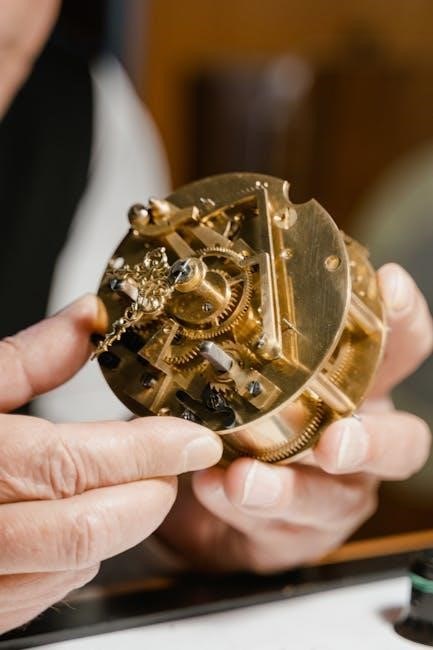Overview of the Sharp Atomic Clock
The Sharp Atomic Clock is a device that utilizes radio signals to maintain accurate timekeeping, ensuring that the user has a reliable and precise timepiece. The clock receives a daily broadcast from the WWVB radio signal, which allows it to display the most accurate date and time. This feature eliminates the need for manual adjustments, providing a hassle-free experience for the user. The Sharp Atomic Clock is designed to be user-friendly, with a simple and intuitive interface that makes it easy to navigate and understand. The device is also equipped with a range of features, including a LCD display and automatic date updates, making it a versatile and practical timekeeping solution. Overall, the Sharp Atomic Clock is a reliable and accurate timepiece that is suitable for a variety of applications, from personal use to professional settings. The clock’s advanced technology and user-friendly design make it an ideal choice for anyone seeking a precise and convenient timekeeping solution.
Importance of the Manual
The manual is a crucial component of the Sharp Atomic Clock, providing users with a comprehensive guide to understanding and operating the device. The manual contains essential information on the clock’s features, functions, and troubleshooting techniques, allowing users to get the most out of their timepiece. By reading the manual, users can learn how to properly set up and maintain their clock, ensuring that it continues to function accurately and efficiently. The manual also serves as a reference point for users who may encounter issues or have questions about their clock’s operation. Additionally, the manual provides valuable insights into the clock’s technical specifications and capabilities, helping users to appreciate the full range of its features and functions. Overall, the manual is an indispensable resource for anyone who owns a Sharp Atomic Clock, and it is highly recommended that users take the time to read and understand its contents. The manual is available for download online, making it easily accessible to users.

Setting Up the Atomic Clock
Receiving the WWVB Signal

The atomic clock receives the WWVB signal from the National Institute of Standards and Technology, which is broadcast from Boulder, Colorado. This signal is used to synchronize the clock’s timekeeping with the official US time standard. The WWVB signal is transmitted at a frequency of 60 kHz and is received by the clock’s internal antenna. The signal strength can be affected by various factors such as location, weather, and nearby electronic devices. To improve signal reception, it is recommended to place the clock near a window or outside wall, away from other electronic devices. The clock will automatically adjust its timekeeping to match the WWVB signal, ensuring accurate timekeeping. The WWVB signal is updated daily, and the clock will synchronize with it automatically. By using the WWVB signal, the atomic clock can maintain an accuracy of one second per million years, making it an extremely reliable timekeeping device. The signal reception process is automatic and does not require any user intervention.
Initial Setup
The initial setup of the atomic clock involves inserting the batteries and placing the clock in a location where it can receive the WWVB signal. The clock comes with a set of instructions that outline the steps for setting up the device. It is recommended to read the instructions carefully before starting the setup process. The clock requires a specific type of battery, and it is important to use the correct type to ensure proper function. Once the batteries are inserted, the clock will begin to search for the WWVB signal and synchronize its timekeeping. The setup process typically takes a few minutes to complete, and the clock will be ready to use once it has synchronized with the WWVB signal. The clock’s display will show the current time and date, and it will also display any error messages or warnings if there are any issues with the setup process. The initial setup is a straightforward process that can be completed by following the instructions provided with the clock.

Troubleshooting the Atomic Clock
Interference and Signal Strength
Consulting the Dealer or Technician

Features of the Atomic Clock
Atomic QA Clock
The atomic QA clock is a feature of the Sharp atomic clock that ensures accurate timekeeping, using a radio signal to synchronize the clock with the WWVB signal. This feature provides an automatic update of the time and date, eliminating the need for manual adjustments. The atomic QA clock is designed to provide a high level of accuracy, with an error margin of only a few seconds per million years. The clock’s ability to receive the WWVB signal allows it to automatically adjust for time zone changes and daylight saving time. The atomic QA clock is a reliable and maintenance-free feature that provides users with accurate timekeeping. The Sharp atomic clock’s QA clock feature is a key component of its overall design, providing a high level of accuracy and reliability. The clock’s use of the WWVB signal ensures that it remains accurate and up-to-date, making it a valuable tool for anyone who needs a reliable timekeeping device.
LCD Weather Forecast Display
The LCD weather forecast display is a feature of the Sharp atomic clock that provides users with current weather conditions and forecasts. The display shows temperature, humidity, and other weather-related information, allowing users to plan their daily activities accordingly. The LCD display is clear and easy to read, making it simple to stay up-to-date on the latest weather conditions. The weather forecast display is updated regularly, ensuring that users have access to the most current information. The Sharp atomic clock’s LCD weather forecast display is a useful tool for anyone who wants to stay informed about the weather. The display is also customizable, allowing users to choose the type of weather information they want to see. Overall, the LCD weather forecast display is a valuable feature of the Sharp atomic clock, providing users with a convenient and easy-to-use way to stay informed about the weather. The display is an added benefit to the clock’s already impressive list of features.